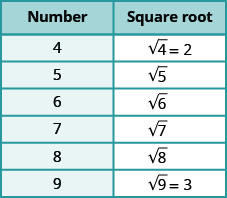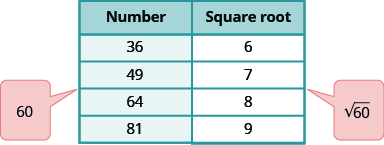| << Chapter < Page | Chapter >> Page > |
Simplify. ⓐ ⓑ
| ⓐ | |
| The negative is in front of the radical sign. |
| ⓑ | |
| The negative is in front of the radical sign. |
Can we simplify Is there a number whose square is
None of the numbers that we have dealt with so far have a square that is Why? Any positive number squared is positive, and any negative number squared is also positive. In the next chapter we will see that all the numbers we work with are called the real numbers. So we say there is no real number equal to If we are asked to find the square root of any negative number, we say that the solution is not a real number.
Simplify: ⓐ ⓑ
ⓐ There is no real number whose square is Therefore, is not a real number.
ⓑ The negative is in front of the radical sign, so we find the opposite of the square root of
| The negative is in front of the radical. |
When using the order of operations to simplify an expression that has square roots, we treat the radical sign as a grouping symbol. We simplify any expressions under the radical sign before performing other operations.
Simplify: ⓐ ⓑ
| ⓐ Use the order of operations. | |
| Simplify each radical. | |
| Add. |
| ⓑ Use the order of operations. | |
| Add under the radical sign. | |
| Simplify. |
Notice the different answers in parts ⓐ and ⓑ of [link] . It is important to follow the order of operations correctly. In ⓐ , we took each square root first and then added them. In ⓑ , we added under the radical sign first and then found the square root.
So far we have only worked with square roots of perfect squares. The square roots of other numbers are not whole numbers.

We might conclude that the square roots of numbers between and will be between and and they will not be whole numbers. Based on the pattern in the table above, we could say that is between and Using inequality symbols, we write
Estimate between two consecutive whole numbers.
Think of the perfect squares closest to Make a small table of these perfect squares and their squares roots.

There are mathematical methods to approximate square roots, but it is much more convenient to use a calculator to find square roots. Find the or key on your calculator. You will to use this key to approximate square roots. When you use your calculator to find the square root of a number that is not a perfect square, the answer that you see is not the exact number. It is an approximation, to the number of digits shown on your calculator’s display. The symbol for an approximation is and it is read approximately .

Notification Switch
Would you like to follow the 'Prealgebra' conversation and receive update notifications?